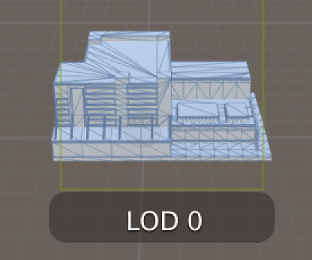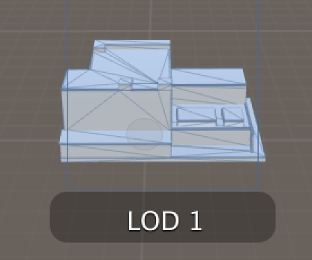Level of Detail (LOD)
When a GameObjectThe fundamental object in Unity scenes, which can represent characters, props, scenery, cameras, waypoints, and more. A GameObject’s functionality is defined by the Components attached to it. More info
See in Glossary in the SceneA Scene contains the environments and menus of your game. Think of each unique Scene file as a unique level. In each Scene, you place your environments, obstacles, and decorations, essentially designing and building your game in pieces. More info
See in Glossary is far away from the CameraA component which creates an image of a particular viewpoint in your scene. The output is either drawn to the screen or captured as a texture. More info
See in Glossary, you can’t see very much detail, compared to when the GameObject is close to the Camera. And even though you can’t see the detail on a distant GameObject, Unity uses the same number of triangles to render it at both distances.
To optimize renderingThe process of drawing graphics to the screen (or to a render texture). By default, the main camera in Unity renders its view to the screen. More info
See in Glossary, you can use the Level Of Detail (LOD) technique. It allows you to reduce the number of triangles rendered for a GameObject as its distance from the Camera increases. You use several Meshes and optionally a Billboard AssetAn asset that is a collection of pre-rendered images of a more complicated Mesh intended for use with the Billboard Renderer, in order to render an object at some distance from a Camera at a lower level of detail (LOD) to save on rendering time. More info
See in Glossary, which all represent the same GameObject with decreasing detail in the geometry. Each of the Meshes contains a Mesh RendererA mesh component that takes the geometry from the Mesh Filter and renders it at the position defined by the object’s Transform component. More info
See in Glossary component and represents a ‘MeshThe main graphics primitive of Unity. Meshes make up a large part of your 3D worlds. Unity supports triangulated or Quadrangulated polygon meshes. Nurbs, Nurms, Subdiv surfaces must be converted to polygons. More info
See in Glossary LODThe Level Of Detail (LOD) technique is an optimization that reduces the number of triangles that Unity has to render for a GameObject when its distance from the Camera increases. Each LOD level has either a Mesh with a Mesh Renderer component (Mesh LOD level) or a Billboard Asset with a Billboard Renderer component (Billboard LOD level). Typically a single GameObject has three or four Mesh LOD levels and one optional Billboard LOD level to represent the same GameObject with decreasing detail in the geometry. More info
See in Glossary level’, while the BillboardA textured 2D object that rotates as it, or the Camera, moves so that it always faces the Camera. More info
See in Glossary Asset has a Billboard RendererRenders Billboard Assets, either from a pre-made Asset (exported from SpeedTree) or from a custom-created file that you create using a script at runtime or from a custom editor, for example. More info
See in Glossary component and represents a ‘Billboard LOD level’.
As long as your GameObjects aren’t all close to the Camera at the same time, LOD reduces the load on the hardware and improves the rendering performance.
Working with LOD levels
In Unity, you use the LOD GroupA component to manage level of detail (LOD) for GameObjects. More info
See in Glossary component to set up LOD rendering for a GameObject. The images below demonstrate how the LOD levels change according to distance from the Camera.

Image 1 shows the first level, LOD 0. This level is the closest to the Camera, and therefore the most detailed LOD level. For example, many first-level LODs are active when the GameObject’s height fills 50% or more of the screen’s height.

Image 2 shows the next level, LOD 1. This level is farther away from the Camera, and therefore is a lower LOD level. For example, many LOD Groups use three levels, where LOD 1 is active when the GameObject fills between 25% and 49% of the screen height, and LOD 2 is active when the GameObject fills less than 25% of the screen height.
Because the arrangement of LOD levels depends on the target platform and available rendering performance, you can set maximum LOD levels and a Lod Bias Quality setting in Unity. The Lod Bias determines whether to favor higher or lower LOD levels at threshold distances.
Naming convention for importing Meshes
When you import a set of LOD Meshes, Unity automatically creates an LOD group for the GameObject with appropriate settings if you follow this naming convention:
- Your set of Meshes have file names ending in
_LODand a number ranging from0to the total number of LOD levels minus one. For example, if the base name for your Mesh is Player, name your filesPlayer_LOD0,Player_LOD1andPlayer_LOD2to generate a Player GameObject with three LOD levels. - Name the most detailed Mesh file
_LOD0. - Make sure the rest of the Mesh file names increment corresponding to decreasing detail.
- Set Billboard LOD levels to have the highest numerical prefix (because they always have the least detailed level).
You can use as many LOD levels as you need.